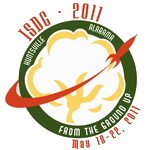About ISDC 2011 and Huntsville
For 30 years, space advocates have gathered at the International Space
Development Conference to discuss progress in developing a spacefaring
civilization. The theme for ISDC 2011
is "From the Ground Up...How Do We
Get There?" The theme and the conference logo pay homage to the humble
beginnings of Huntsville as a cotton town to the Rocket City.
This transformation happened thanks to
Redstone Arsenal and
Dr. Wernher von Braun's team of scientists, who developed America's ballistic missiles,
which were eventually transformed to launch America's first satellite,
first man into space, first man in orbit, first men on the Moon, first
reusable Space Shuttle, and the nation's next-generation launch vehicle.
ISDC 2011 will not just focus on Huntsville's storied past, but on what
the Rocket City and people from around the world can do to keep things
moving from the ground up.
Since its inception, ISDC has been a great forum for the dreamers and
builders of the space business. The first ISDC was held in Los Angeles,
California in 1981 to herald in America's return to space with the
reusable Space Shuttle. The 1993 ISDC landed in Huntsville Alabama, the
birthplace of U.S. Space Program, and commonly known as Rocket City,
USA, and it was a great success. For the 30th ISDC in 2011, the
conference returns to Huntsville, and is hosted again by the
Huntsville Alabama L5 Society (HAL5), the Huntsville chapter of NSS.
The 1993 ISDC lived up to its theme, "Founding the Future." For
instance, ISDC 1993 saw Peter Diamandis, Ray Cronise, and Astronaut
Byron Lichtenberg spark their plans for what became the X PRIZE
Foundation. In addition, HAL5 used proceeds from the ISDC to start the
High Altitude Lift-Off (HALO) Program,
which developed hybrid rockets
and launched them from high-altitude balloons into near-space.
On May 11, 1997, HAL5 made history for amateur rocketry altitude and the
world's first high-altitude ignition of a hybrid rocket. This daring
feat was later recorded in the 2000 Guinness Book of World Records. HALO
spin-offs include the High Altitude Research Corporation, which
developed the Balloon Launched Return Vehicle (a rocket-powered,
balloon-launched, remotely-piloted wing-body) and was the only entry
that attempted launch during the Cheap Access to Space (CATS) Prize. The
hybrid propulsion technologies developed by these projects were
transferred directly to the motor used in SpaceShipOne, the first
privately funded vehicle to reach space and win the X PRIZE.
From concept to reality, the 1993 ISDC played a key role in "Founding
the Future!" Since 1993, Huntsville and surrounding area have grown
leaps and bounds. It is our pleasure to show the world what Huntsville,
North Alabama and Middle Tennessee have to offer.
Orion Propulsion is another highly successful spin-off of these
programs. While Orion has since been bought by
Dynetics,
many of the same team players are now working on cutting-edge projects such as the
thrusters on the Bigelow Aerospace Sundancer private space station. From
concept to reality, the 1993 ISDC played a key role in "Founding the
Future!"
Huntsville has been home to
NASA's George C. Marshall Space Flight Center
since it was formed in 1960. The Marshall Space Flight Center is
the base of operations for the NASA Space Shuttle's propulsion systems,
the scientific experiments of the International Space Station (ISS), ISS
payload Huntsville Operation Support Center, NASA National Space Science
and Technology Center, and NASA's future exploration launch vehicles. In
addition to NASA, the city is the location of Redstone Arsenal, where
the agencies such as United States' Army Aviation and Missile Command,
Army Space and Missile Defense Command, and Missile Defense Agency call
home. Huntsville also is home to several universities and colleges,
telecommunications and biotechnology companies including the HudsonAlpha
Institute, as well as Cummings Research Park,
the nation's third-largest and one of the world's leading science and technology business parks.
The conference will focus on Huntsville's, Northern Alabama's, and
middle Tennessee's efforts in space and other high technology. The
region has a high concentration of experts in multiple fields, including
human space exploration, space science, as well as "new space"
entrepreneurs, Earth-based space applications, and biotechnology. The
conference also will provide a venue for showcasing various space-
related activities from around the country and around the world.
ISDC 2011 will start with a one-day Space Investment Summit, where the
next wave of entrepreneurs will learn how to line up potential investors
and how to market their ideas. The conference follows three major
themes: transportation, technology, and culture. If NSS is serious about
building a spacefaring civilization, the time is now. Our goals require
vehicles to get us there, technologies to sustain and enrich human life,
and a political culture and economy that are committed to ensuring that
human beings are in space to stay. To help us showcase these important
topics, HAL5 will be joined by national-level organizations like the
Space Frontier Foundation and Explore Mars, Inc., as well as local
partners like the Von Braun Astronomical Society and Huntsville Space
Professionals. In addition to the regular tracks, to take advantage of
the expertise in Huntsville, ISDC 2011 will host several workshops and
plenary sessions on future missions to the International Space Station
(ISS), how to get your payload onto ISS, Space Launch System mission
development, commercial space activities, and International Space-Based
Solar Power Symposia.
Content extracted from the Spring 2011 issue of Ad Astra, the magazine of the National Spaec Society.





















































